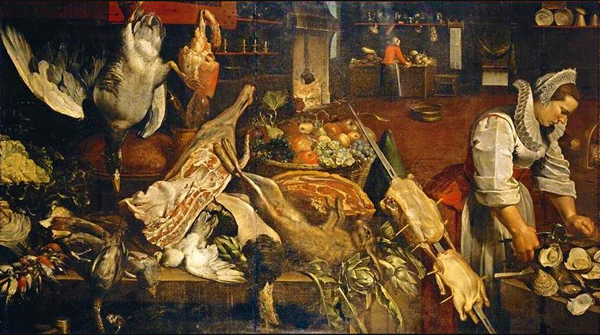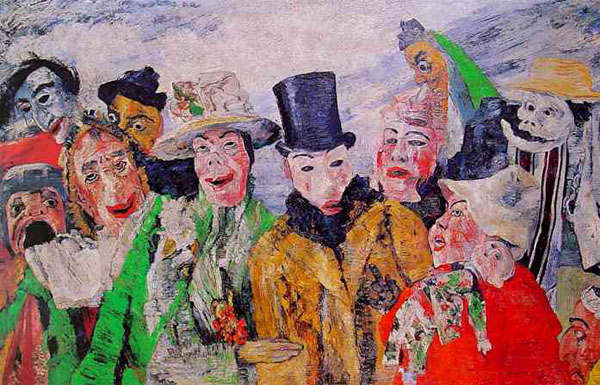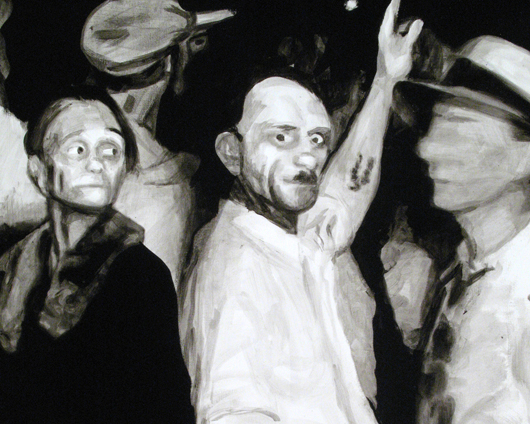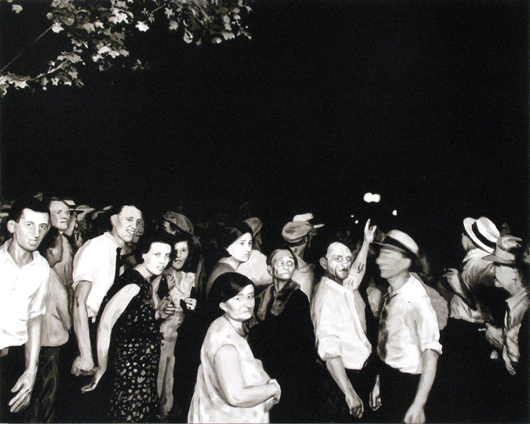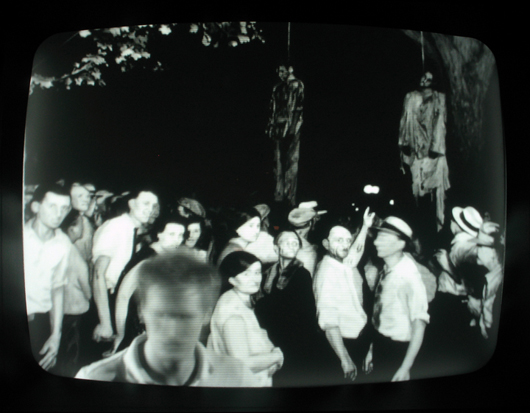A critic once described the painter James Ensor’s inner world as
too redolent of pitiable psychological distortions for me to visit longer than half an hour… I always skipped the fun house when I went to the county fair. Huntley Dent in The Berkshire Review
Me, I crave the funhouse. It distorts the familiar into questions you haven’t asked. Facts that you can’t pin down loom large — or shrink to magic beans.
Lawrence Norfolk’s novel John Saturnall’s Feast has a particular flavor of darkness that I needed to separate from the novel’s succulence. Norfolk has no problem handling them together — I did.
James Ensor painted the darkness in the menacing faces of The Intrigue.
The Intrigue by James Ensor via The Berkshire Review
Social masks sitting lopsided on humans who hide incendiary tar pits of malice and fury below. Human beings eager to bond ids and do harm as a pack. The House Unamerican Activities Committee. The Inquisition. Lynch mobs. Germany’s Kristallnacht. Amazing how hard it is to find paintings that conjure this part of human nature. Not wars (plenty of battle scenes) but the raw face of human hatred unleashed.
The artist Oliver Lutz has made art from a famous lynching photograph.
The original photo was taken on August 9th 1930, on the evening of the lynching of Abram Smith and Thomas Shipp in Marion, Indiana. The photo, which was taken by studio photographer Lawrence Beitler, was printed (and distributed) as a postcard – a common practice in lynching culture of the United States during that period. In the photograph, lynchers and spectators are shown congragated below the two bodies that hung from a tree. Some people looked towards the bodies while smoking (or lighting) cigars, while others posed for the photographer. The rags clenched in the hands of a few, are commonly thought to be the torn remains of the pants of Abram Smith, also a common souvenir practice of that time.
Lynching 1 painting by Oliver Lutz (detail) This image and the following via Lutz’s website
The entire Lynching 1 painting
Monitor view of the installation Lynching 1
Image of CCTV monitor displaying live surveillance video of the painting (and viewer watching monitor). The bodies of the deceased are only visible to the viewer once s/he looks in the monitor (and inadvertently becomes part of the spectator mob).
The harsh revealing artistry of his brushy paint. Murderous mobs have ignited like gunpowder and dispersed in wisps throughout humans’ life on Earth.
________________________________________________
Gristly images aren’t as disturbing as, say, Goya’s dark paintings. His Saturn Devouring His Son doesn’t scare me but his Witches’ Sabbath does.
Witches’ Sabbath (The Great He-Goat) by Francisco Goya via WikiMedia
Jim Jones and his Kool-Aid. Herr Goebbels of Hitler’s Propaganda Ministry. You will meet the He-Goat in Norfolk’s book. He-Goat, She-Goat, Pied Piper of our inward urges to join the dog pack and be off ravening.
It’s striking how difficult it is to find paintings that depict the face of raw violence. It’s possible that while people are in the frenzy they can’t see what the funhouse mirror does to faces around them. Or maybe it’s a database blindness, an unwillingness to tag the despicable. Search for lynching, violent mobs, hatred — you get boxcars of news photographs. If Rembrandt had ever seen the face of true evil what complicated face would he have left whose eyes would gimlet ours?
________________________________________________
In 2011 while the state of Wisconsin was trying to bust the teachers’ unions I happened to read this description of a British pub in a book by the poet Robert Hass:
“…built just before the regency in the year when the first man who tried to organize a craft union among weavers was whipped, drawn, quartered and disemboweled in a public ceremony in London” via the essay Lowell’s Graveyard, in Twentieth Century Pleasures by Robert Hass
The uproar in the state of Wisconsin made this quote resonate like a gong. Yet today there is a London Guild of Weavers Spinners and Dyers. Gauge the above against this from the guild’s current website:
Publicity has always been important for the guild – in the 1980s the British Wool Marketing Board invited the London Guild to try to break the world ‘sheep to shoulder’ record (creating a knitted jersey from a fleece shorn on the spot). This we did successfully, taking 8 minutes off the record. via London Guild of Weavers Spinners and Dyers
________________________________________________
Look further:
The darkness in literature
- • Waiting for the Barbarians, a novel by J. M. Coetzee. There’s a reason he won a Nobel prize.
- • The Lottery, short story by Shirley Jackson. Different dark, but the very same.
The darkness in news, two commentaries
- • ‘Perplexed … Perplexed’: On Mob Justice in Nigeria by Teju Cole in The Atlantic. Strong article but filled with things I didn’t know about life in Nigeria.
- • Is Delhi So Different From Steubenville? by Nicholas Kristof in the New York Times. Nicholas Kristof is a a man of mighty conscience and physical bravery.
Twentieth Century Pleasures by Robert Hass
- • In 2011 I wrote Robert Hass asking for the source of his disturbing facts. If you want to look further: The Making of the English Working Class by E. P. Thompson. Hass said I think it is in the first chapter — and so it is. Read it and then thank Hass for his linguistic gifts.
- • Hass’s fine book of essays is Twentieth Century Pleasures.

